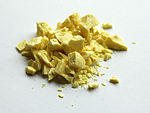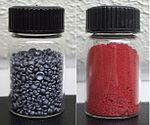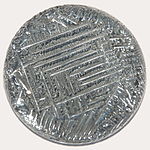- Chalcogen
-
Group 16 Period 2 
8
O3 
16
S4 
34
Se5 
52
Te6 84
Po7 116
UuhThe chalcogens (pronounced /ˈkælkədʒɨn/) are the chemical elements in group 16 (old-style: VIB or VIA) of the periodic table. This group is also known as the oxygen family. It consists of the elements oxygen (O), sulfur (S), selenium (Se), tellurium (Te), the radioactive element polonium (Po), and the synthetic element ununhexium (Uuh).
Although all group 16 elements of the periodic table, including oxygen are defined as chalcogens, oxygen and oxides are usually distinguished from chalcogens and chalcogenides. The term chalcogenide is more commonly reserved for sulfides, selenides, and tellurides, rather than for oxides.[1][2][3][4] Binary compounds of the chalcogens are called chalcogenides (rather than chalcides; however, this breaks the pattern of halogen/halide and pnictogen/pnictide).
Although the word "chalcogen" is literally taken from Greek words being "copper-former", the meaning is more in line with "copper-ore former" or more generally, "ore-former". These electronegative elements are strongly associated with metal-bearing minerals, where they have formed water-insoluble compounds with the metals in the ores.
Contents
Properties
Members of this group show similar patterns in their electron configuration, especially the outermost shells, resulting in similar trends in chemical behavior:
Z Element No. of electrons/shell 8 oxygen 2, 6 16 sulfur 2, 8, 6 34 selenium 2, 8, 18, 6 52 tellurium 2, 8, 18, 18, 6 84 polonium 2, 8, 18, 32, 18, 6 116 ununhexium 2, 8, 18, 32, 32, 18, 6 Oxygen and sulfur are nonmetals, and selenium, tellurium, and polonium are metalloid semiconductors (that means, their electrical properties are between those of a metal and an insulator). Nevertheless, tellurium, as well as selenium, is often referred to as a metal when in elemental form.
Metal chalcogenides are common as minerals. For example, pyrite (FeS2) is an iron ore. The rare mineral calaverite is the ditelluride AuTe2.
The formal oxidation number of the most common chalcogen compounds is −2. Other values, such as −1 in pyrite, can be attained. The highest formal oxidation number +6 is found in sulfates, selenates and tellurates, such as in sulfuric acid or sodium selenate (Na2SeO4).
Explanation of above periodic table slice: Nonmetals Metalloids Poor metals Atomic numbers in red are gases Atomic numbers in black are solids Solid borders indicate primordial elements (older than the Earth) Dashed borders indicate radioactive natural elements Dotted borders indicate radioactive synthetic elements Etymology
The name chalcogen comes from the Greek words χαλκος (chalkos, literally "copper"), and γενές (genes, born,[5] gender, kindle). Thus the chalcogens bear copper. It was first used around 1930 by Wilhelm Biltz's group at the University of Hanover, where it was proposed by a man named Werner Fischer.[6] Although the literal meanings of the Greek words imply that chalcogen means "copper-former", this is misleading because the chalcogens have nothing to do with copper in particular. "Ore-former" has been suggested as a better translation,[7] wherefore both the vast majority of metal ores are chalcogenides and the word χαλκος in ancient Greek was associated with metals and metal-bearing rock in general; copper, and its alloy bronze, was one of the first metals to be used by humans.
See also
References
- ^ A Second Note on the Term "Chalcogen"
- ^ Francesco Devillanova (Editor) Handbook of Chalcogen Chemistry - New Perspectives in Sulfur, Selenium and Tellurium Royal Society of Chemistry, 2007; ISBN 0854043667, 9780854043668
- ^ IUPAC goldbook amides. Chalcogen replacement analogues (of amides) are called thio-, seleno- and telluro-amides.
- ^ Ohno Takahisa Passivation of GaAs(001) surfaces by chalcogen atoms (S, Se and Te) Surface Science; Volume 255, Issue 3, 2 September 1991, Pages 229-236; doi:10.1016/0039-6028(91)90679-M
- ^ Online Etymology Dictionary -gen
- ^ Werner Fischer (2001). "A Second Note on the Term "Chalcogen"". Journal of Chemical Education 78 (10): 1333. Bibcode 2001JChEd..78.1333F. doi:10.1021/ed078p1333.1.
- ^ William B. Jensen (1997). "A Note on the Term "Chalcogen"". Journal of Chemical Education 74 (9): 1063. Bibcode 1997JChEd..74.1063J. doi:10.1021/ed074p1063.
Periodic tables Layouts - Standard
- Large table
- Inline f-block
- Vertical
- Text only
- Metals and nonmetals
- Blocks
- Valences
- Extension beyond the 7th period
- Large extended table
- Electron configurations
- Electronegativities
- Alternatives
- Crystal structure
- Discovery periods
List of elements by - Name etymology (symbol)
- Discovery
- Oxidation state
- Abundance (in humans)
- Nuclear stability
- Hardness
- Atomic properties
- Production
Groups Other element categories - Periods
- Metals
- Transition metals
- Metalloids
- Nonmetals
- Lanthanides
- Actinides
- Rare earth elements
- Platinum group metals (PGMs)
- Post-transition metals
- Refractory metals
Blocks Periods Chalcogens Oxygen
O
Atomic Number: 8
Atomic Weight: 15.9994
Melting Point: 50.5 K
Boiling Point: 90.20 K
Specific mass: 0.001429 g/cm3
Electronegativity: 3.04Sulfur
S
Atomic Number: 16
Atomic Weight: 32.065
Melting Point: 388.51 K
Boiling Point: 717.8 K
Specific mass: 2.067 g/cm3
Electronegativity: 2.58Selenium
Se
Atomic Number: 34
Atomic Weight: 78.96
Melting Point: 494.15 K
Boiling Point: 958 K
Specific mass: 4.809 g/cm3
Electronegativity: 2.55Tellurium
Te
Atomic Number: 52
Atomic Weight: 127.60
Melting Point: 722.8 K
Boiling Point: 1261 K
Specific mass: 6.232 g/cm3
Electronegativity: 2.1Polonium
Po
Atomic Number: 84
Atomic Weight: 210
Melting Point: 527.15 K
Boiling Point: 1235 K
Specific mass: 9.32 g/cm3
Electronegativity: 2Ununhexium
Uuh
Atomic Number: 116
Atomic Weight: 292
Melting Point: ? K
Boiling Point: ? K
Specific mass: ? g/cm3
Electronegativity: ?Categories:- Periodic table
- Chalcogens
- Chemical element groups
Wikimedia Foundation. 2010.

